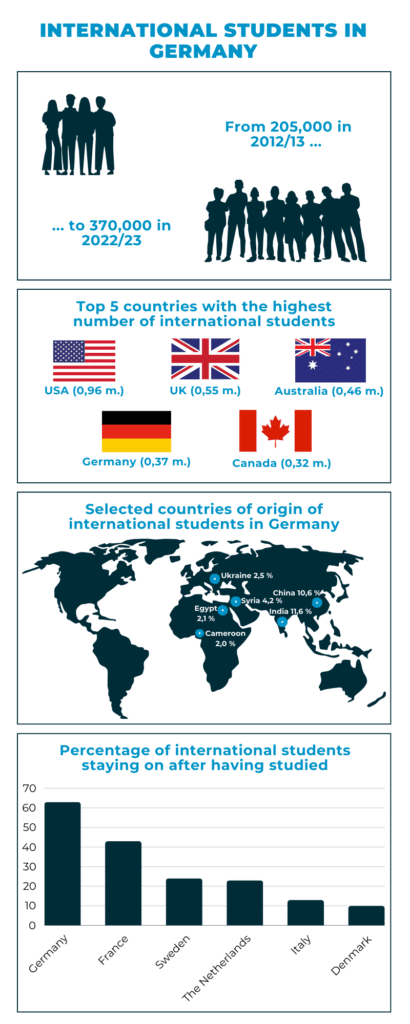Germany needs international students to compensate for the declining number of students and to meet the demand for highly skilled workers. Foreign students who successfully complete their studies can then integrate into the labour market. At first glance, this is already happening quite well, as statistics and reports on the number of international students show (e.g. Federal Statistical Office of Germany, DAAD reports). But there is still a lot of room for improvement.
However, there are two problems that are significant:
1. The number of international students is still too low. Although the number of international first-year students has risen from 125,400 to 128,500 (+2.5%) between the academic year 2019 and 2022, the number of German first-year students has fallen from 383,300 to 346,400 (-9.6%) over the same period. The increase in the number of international students is therefore not sufficient to compensate for the decline in the number of German students.
2. The drop-out rate of international students in Germany is too high: It is between 41 and 45 per cent in Bachelor’s programmes (for international students), while the drop-out rate for Germans is significantly lower at 27 to 31 per cent. The drop-out rate is also higher in Master’s programmes at 26 to 34 per cent (compared to 17 to 23 per cent).
Why are international student drop-out rates so high? Unfortunately, comprehensive data and explanations are not (yet) available, and even dropout rates are difficult to determine statistically. Nevertheless, there are first indications.

Germany needs international students to compensate for the declining number of students and to meet the demand for highly skilled workers. Foreign students who successfully complete their studies can then integrate into the labour market. At first glance, this is already happening quite well, as statistics and reports on the number of international students show (e.g. Federal Statistical Office of Germany, DAAD reports). But there is still a lot of room for improvement.
However, there are two problems that are significant:
1. The number of international students is still too low. Although the number of international first-year students has risen from 125,400 to 128,500 (+2.5%) between the academic year 2019 and 2022, the number of German first-year students has fallen from 383,300 to 346,400 (-9.6%) over the same period. The increase in the number of international students is therefore not sufficient to compensate for the decline in the number of German students.
2. The drop-out rate of international students in Germany is too high: It is between 41 and 45 per cent in Bachelor’s programmes (for international students), while the drop-out rate for Germans is significantly lower at 27 to 31 per cent. The drop-out rate is also higher in Master’s programmes at 26 to 34 per cent (compared to 17 to 23 per cent).
Why are international student drop-out rates so high? Unfortunately, comprehensive data and explanations are not (yet) available, and even dropout rates are difficult to determine statistically. Nevertheless, there are first indications.

Difficulties for international students
In a survey (International Student Survey, cited in Pineda et al., 2022), foreign students who dropped out of their bachelor’s programme gave the following reasons for dropping out:
- lack of motivation to study (37%)
- performance problems (33%)
- financial situation (33%)
- other reasons cited by more than 10 per cent were the desire for practical work, personal reasons, study conditions, career alternatives and the family situation.
Another study (DAAD, 2023) asked international students about various aspects of their studies in Germany. On the one hand, many of the services offered by the universities were rated positively by the majority, such as information about studying on the Internet or the work of the International Office. On the other hand, the majority of respondents did not rate positively the opportunities for making contact with fellow students and social contacts in general, language skills (in everyday life as well as in studies), psychological counselling, help in finding accommodation and bureaucratic formalities. Regarding the demands of the studies, 36.2% felt that the difficulty was too high and 51.3% that the quantity to learn was too high.
In summary, there appear to be five areas that cause drop-out of international students:
- academic performance and motivation
- language skills
- social contacts
- finances
- organisation
Approaches for improving the success rate in higher education
A distinction can be made between approaches that begin before study begins and those that take effect during study. The approaches address the reasons why international students drop out of university and help to prevent them from dropping out.
Approaches before study begins
- Send out admission confirmations earlier: According to a paper of the Stifterverband from 2019, international students should have at least three months between the admission and the start of their studies to overcome the many hurdles (e.g. bureaucratic procedures like visa) before entering the country. According to a survey, many international students do not receive their admission letter in time. 38 per cent of non-EU foreigners arrive in Germany after the start of the semester. This means that valuable time is lost, and instead of preparing and integrating, international students start catching up on their studies. It is therefore advisable to shorten the admission procedures – so that international students have the time they need to “arrive”.
- Consider academic aptitude in admissions and selection: Academic aptitude is the best predictor of academic success, as many empirical studies have shown. Aptitude can be measured well using standardised tests. However, aptitude currently plays little role in either access or admission to higher education for international students. The focus is on formal qualifications, such as the equivalence of the higher education entrance qualification according to the criteria of the Central Office for Foreign Education (ZAB). However, surveys of students and analyses of dropout rates suggest that aptitude for study should be assessed and payed more attention to in terms of access and admission. Legislation in some federal states of Germany has already created the basis for this. Universities can grant talented international applicants direct access if they pass an aptitude test – even if the final exam is not equivalent according to the ZAB criteria.
Approaches during study
- Support language learning: In surveys, over 50 per cent of international students report difficulties with the German language. It is therefore important that international students are given comprehensive opportunities to improve their language skills before and at the start of their studies. This could be achieved through intensive language courses and language preparation programmes, which some universities already offer. Proficiency in the language of the study and in the language of the country in which the study takes place is essential for academic success.
- Offer buddy programmes: Organised partnerships between local and international students are key to faster integration at university. By being assigned a ‘buddy’, international students receive support in navigating university structures and assistance with non-academic challenges such as finding accommodation and dealing with the public authorities. Buddy programmes also provide an excellent platform for making social contacts quickly.
- Improve guidance and counselling specifically for international students: Tailor-made advisory services focus on issues and challenges that primarily affect international students. These include, in particular, features of the higher education system, funding, accommodation, language courses and dealing with public authorities.
Thus, despite the many and largely successful efforts of universities to admit international students, there are still a number of areas where universities can take action to increase the number of successful foreign graduates.
Further Information is provided in the following publications:
DZHW/DAAD (2023). Wissenschaft weltoffen. Facts and Figures on the International Nature of Studies and Research in Germany and Worldwide. DOI: 10.3278/7004002vew
Pineda, J., Kercher, J., Falk, S., Thies, T., Yildirim, H. H., & Zimmermann, J. (2022). Accompanying international students in Germany to academic success: results and recommendations from the SeSaBa project (DAAD Studies). Bonn: DAAD. https://doi.org/10.46685/DAADStudien.2022.07



